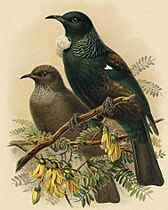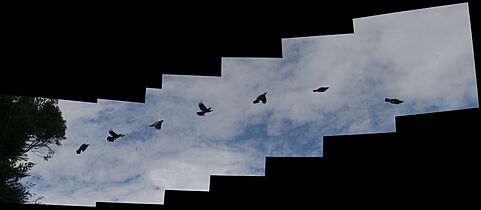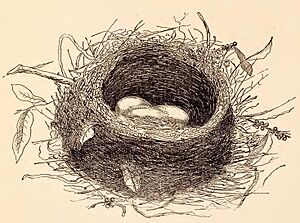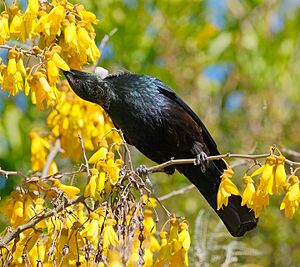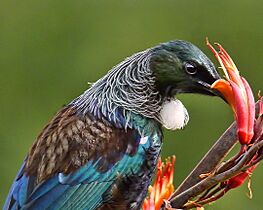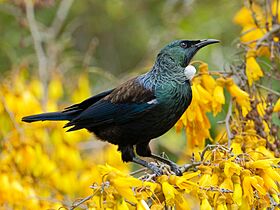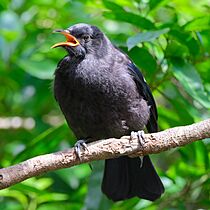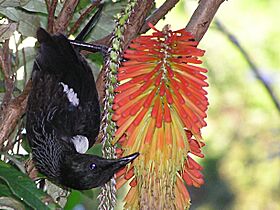Tūī facts for kids
Quick facts for kids Tūī |
|
|---|---|
 |
|
| Tūī on a flax flower stalk, with pollen on its beak | |
| Conservation status | |
| Scientific classification | |
| Genus: |
Prosthemadera
|
| Species: |
novaeseelandiae
|
The tūī (Prosthemadera novaeseelandiae) is a lively, medium-sized bird from New Zealand. It has beautiful blue, green, and bronze feathers. A special white fluffy tuft (called a poi) sits on its throat. This bird is found only in New Zealand. It is the only species in its group, called Prosthemadera.
The tūī is one of the biggest birds in the honeyeater family. Honeyeaters love to drink nectar from flowers. Another honeyeater in New Zealand is the New Zealand bellbird. Tūī live all over New Zealand. You can find them from the warm Kermadec Islands to the cooler Auckland Islands.
Contents
What is a Tūī?
The tūī is a large honeyeater bird. It grows to be about 27 to 32 centimeters (11 to 13 inches) long. Tūī on the Chatham Islands are usually bigger and heavier. Male tūī are often heavier than females.
At first, a tūī might look completely black. But if you look closely, you'll see amazing colors! They have brown feathers on their back and sides. Their feathers also shimmer with many colors, like a rainbow. This iridescent shine changes depending on how the light hits them. They also have tiny white feathers on their neck. These feathers look like a lacy collar.
-
A tūī feeding on an exotic tree's nectar
Where Do Tūī Live?
Tūī are native to New Zealand. This means they naturally belong there. You can find them across the country. They are common on the North Island and parts of the South Island. They also live on Stewart Island / Rakiura and the Chatham Islands. A special kind of tūī lives only on the Chatham Islands.
Tūī also live on Raoul Island and the Auckland Islands. In the Auckland Islands, they are the southernmost honeyeater birds. Long ago, Māori people used to eat tūī. They would keep the birds in special gourds.
Since Europeans arrived, tūī numbers have gone down. This is mostly because their homes (habitats) were destroyed. Also, new animals brought to New Zealand, like possums and cats, hunt tūī. These new animals are called invasive species. Possums eat tūī eggs and chicks. Cats, stoats, and rats also hunt them. Even common myna birds can compete for food and sometimes take eggs.
But tūī populations are getting better in some places. This happens when farm animals are removed. Then, the plants and trees can grow back.
Tūī like forests with wide-leaf trees. They prefer lower areas, but can live up to 1500 meters high. They can even live in small patches of forest. You can also find them in gardens and well-planted suburbs. They are very common in the city of Wellington.
Tūī are usually seen alone, in pairs, or in small family groups. But they gather in large numbers when there's a lot of food. They often hang out with silvereyes, bellbirds, or kererū (New Zealand pigeons). Tūī are usually the boss when they are with bellbirds. They often chase bellbirds away from good food spots, like a flowering flax plant.
Tūī Behavior
Male tūī can be very aggressive. They chase other birds, big or small, away from their home area (their territory). They make loud flapping sounds and noises that sound like rude human speech. This is especially true when another tūī tries to use their favorite feeding tree. Tūī will fluff up their feathers to look bigger. This helps them scare away rivals. They have even been seen chasing harriers (birds of prey) and magpies.
Tūī have short, wide wings. This helps them fly very well in thick forests. But it also means their flight is quite loud because they flap their wings fast. During mating season (early spring, September and October), you might see them do a special flight. They fly straight up very fast, then stop and dive down quickly. Then they repeat it!
Tūī's Diet
Tūī mostly eat nectar from flowers. But they also eat fruit and insects often. Sometimes they eat pollen and seeds too. They especially love the New Zealand flax plant. Tūī are very important for pollinating plants. They help spread pollen for flax, kōwhai, kaka beak, and other plants. The flowers of these plants are shaped like the tūī's beak. This is a great example of how birds and plants help each other. This is called mutualism.
Tūī Life Cycle
Both male and female tūī help build their nest. It's a large, messy, cup-shaped nest made of twigs, grasses, and moss. But the female does most of the work.
A tūī usually lays 4 eggs. The eggs are pale pink or white. They have light red spots, mostly at the bigger end. The average egg size is about 27.5 x 20.3 millimeters. The female sits on the eggs for 14 days to keep them warm. This is called incubation.
Only the female keeps the chicks warm after they hatch. But both parents feed the young birds. They also remove the chicks' waste. The chicks leave the nest after about 20 days. Their parents continue to feed them for another two weeks.
Tūī Songs and Calls
Tūī are famous for their loud, unusual, and sometimes beautiful calls. Each tūī has its own unique sounds. Their calls can sound like bellbirds, clicks, cackles, creaks, groans, and even wheezing.
Tūī have many different songs and calls, just like parrots. They can even copy human speech very clearly! Māori people used to train tūī to repeat complex words. Tūī can also copy sounds like breaking glass, car alarms, classical music, and even jingles from commercials.
Birds have a special organ for making sounds called a syrinx. Songbirds like tūī have many muscles in their syrinx. This lets them make very complex sounds. You can see them move a lot when they sing. Tūī have a "dual voice box." This means they can make two sounds at the same time! Tūī songs also change depending on where they live, the time of year, their gender, and even their own personality. Tūī sometimes sing at night, especially when the moon is full.
How Tūī Got Their Name
The name "tūī" comes from the Māori language. In modern New Zealand English, the plural (more than one tūī) is also "tūī." In Māori, it's "ngā tūī." Some people still add an 's' to make "tūīs," but this is becoming less common.
For many years, the name was spelled "tui." It didn't have the macrons (the little lines over the vowels). Macrons show that a vowel sound is long. Now, it's common to spell Māori words with macrons in New Zealand. The International Ornithologists' Union (IOC) doesn't use accents. So, they list the bird's English name as "Tui."
Early European settlers called the tūī the "parson bird" or "mocking-bird." This was because its white throat tuft looked like a parson's collar. Also, it could copy other sounds. But these names are not used anymore.
Tūī Family Tree
The closest living relative to the tūī is the New Zealand bellbird. Scientists have studied their genes. They found that the tūī's ancestor separated from the bellbird family about 5 million years ago. The chart below shows how they are related:
|
||||||||||||||||||||||||||||
Gallery
- Tūī
-
Tūī feeding on harakeke
See also
 In Spanish: Mielero tui para niños
In Spanish: Mielero tui para niños



